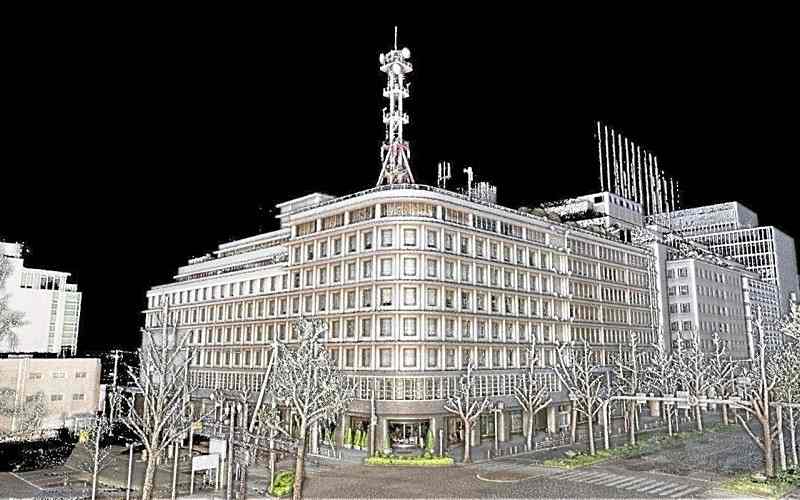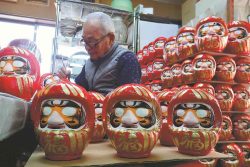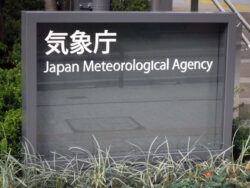
A 3D image of the Osaka Gas Building
20:00 JST, September 20, 2022
Historically and architecturally important buildings are increasingly being preserved with the help of 3D data, as advancements in surveying technologies have made it possible to record not only the structure of a building but its exterior.
The data are being used for such purposes as maintenance and the restoration of buildings damaged by disasters.
Highly accurate
Three-dimensional computer graphics of the Osaka Gas Building in Osaka City, a government-registered tangible cultural property that was completed in 1933, can be seen on YouTube. The images present a highly accurate reproduction of such details as patterns on the walls, internal stairways and the shapes of pillars.
People involved in creating the graphics said elements such as the size and angle of inclination of the walls and pillars are accurate to within a few millimeters.
A technology called 3D scanning was used to create the graphics. Laser beams are projected onto buildings from specialized devices, and the distance is measured to create three-dimensional shapes.
Hundreds of millions of coordinate points are collected, and the 3D data are converted into CG images.
In conventional surveying, at least two people manually take measurements while confirming them against printed records. 3D scanning greatly improves efficiency and accuracy, and has therefore been widely introduced at construction sites.
Three-dimensional scanning was originally developed for the maintenance and management of buildings with high cultural value. Because such structures are usually not open to the public, the 3D images of Osaka Gas Building were put online so that as many people as possible could see the building’s interior.
Capsule tower
The 3D data was created for the Osaka Gas Building by Kumonos Corp., a surveying company based in Mino, Osaka Prefecture.
Kumonos has produced 3D data for about 20 years, covering more than 2,000 projects.
The buildings involved include the Nakagin Capsule Tower Building in Tokyo, which was designed by Kisho Kurokawa and is representative of the Metabolism architectural movement that originated in Japan, and Ninna-ji Kondo temple hall in Kyoto, which is a designated national treasure. It has also produced data for the Osaka City Central Public Hall in Osaka City.
Initially, 3D data of buildings were mainly used as basic data related to construction work. Recently, however, finished buildings are increasingly being recorded or promoted.
Due to dramatic progress in image-making technologies thanks to laser scanning and computer graphics, use of 3D scanning started rapidly widening several years ago.
“Real buildings deteriorate, but 3D data can be passed on through the generations for cultural properties and other structures,” a Kumonos project chief said.
Restoring Kumamoto Castle
Kumamoto University and Toppan Inc. have applied 3D scanning to past photos of Kumamoto Castle to restore stone walls that collapsed in the 2016 Kumamoto Earthquakes.
CG images were made for tourism promotion in 2011 before the stone walls collapsed. By using more than 40,000 copies of photos taken at the time and the CG, the university and the company created 3D data of the stone walls.
Based on the data, they made a database of the shapes of stone materials and their original positions, aiming to check them against data on the stone materials that collapsed.
“Three-dimensional scanning can also record traces of how the buildings were used. From now on, it will likely be standard procedure for important buildings to be recorded as 3D data,” said Keisuke Toyoda, an architect and project professor at the Institute of Industrial Science, the University of Tokyo.
"Society" POPULAR ARTICLE
-

M4.9 Earthquake Hits Tokyo, Neighboring Prefectures
-

Israeli Tourists Refused Accommodation at Hotel in Japan’s Nagano Pref., Prompting Protest by Israeli Embassy and Probe by Prefecture
-

M7.5 Earthquake Hits Northern Japan; Tsunami Waves Observed in Hokkaido, Aomori and Iwate Prefectures
-

Tsukiji Market Urges Tourists to Avoid Visiting in Year-End
-

High School in Kyoto Says Students Shoplifted during Recent School Trip to Bali, Indonesia
JN ACCESS RANKING
-

Tokyo Economic Security Forum to Hold Inaugural Meeting Amid Tense Global Environment
-

Keidanren Chairman Yoshinobu Tsutsui Visits Kashiwazaki-Kariwa Nuclear Power Plant; Inspects New Emergency Safety System
-

Imports of Rare Earths from China Facing Delays, May Be Caused by Deterioration of Japan-China Relations
-

University of Tokyo Professor Discusses Japanese Economic Security in Interview Ahead of Forum
-

Japan Pulls out of Vietnam Nuclear Project, Complicating Hanoi’s Power Plans























